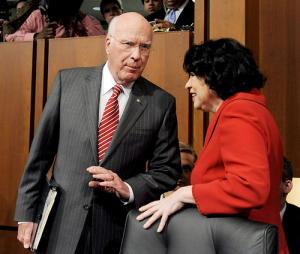
While hearings take place this week before the Senate Judiciary Committee to determine whether to appoint President Obama’s selection of Sonia Sotomayor to the U.S. Supreme Court, much punditry in the greensphere has been dedicated to Sotomayor’s environmental record as a federal judge.
Though environmental factors are not expected to carry much weight in her examination, she has been positively endorsed by 60 national and regional environmental groups, including Clean Water Action, Greenpeace USA, National Audubon Society, Colorado Environmental Coalition, Minnesota Center For Environmental Advocacy, PennFuture and Ohio Environmental Council.
Slim Environmental Record
Many supporters tout Sotomayor as demonstrating a very thorough, well-researched approach to deciding questions of law. She spent over decade on the bench of the Second Circuit U.S. Court of Appeals and prior to that served as a federal District Judge in the Southern District of New York. Her judicial catalog of environmental decisions is not large at all, with nearly every commentator pointing to a 2007 decision she authored in Riverkeeper Inc., et al. v. U.S. Environmental Protection Agency, et al. in favor of environmentalists as to whether the U.S. Environmental Protection Agency can rely on a cost-benefit analysis, as opposed to a cost effectiveness analysis, of steps required by power companies to protect fish and aquatic life from getting trapped in water intake equipment.
The Riverkeeper case was complicated and the decision, one of several in the case, granted in part and denied in part arguments from both sides. Ultimately, the Second Circuit concluded that Congress intended for cost considerations under the Clean Water Act to shift from a cost-benefit breakdown to a cost-effectiveness analysis. Writing for the court, Sotomayor determined that a specified benefit was already established, indicating that power facilities must adopt the best technology available; the court remanded several issues to the EPA for clarification.
A criticism of Sotomayor’s detractors is that this April the Supreme Court overturned that decision in a 6-3 opinion.
In another case, as the environmental groups’ endorsement letter notes, Sotomayor favored a law requiring labels to disclose whether products contain mercury and must be disposed of as hazardous waste, while in another case she sided with the EPA. Her limited portfolio of environmental decisions should not be an indicator of a lack of interest in environmental issues, however; there are environmental law issues that have not been raised in the Second Circuit or reached the federal appellate court.
Fair Decider
Tripp Van Noppen, President of Earthjustice, recently explained to Grist that her record shows that she recognizes the rights of citizens to challenge regulatory authorities should they fail to enforce rules and also upholds the authority of environmental regulatory agencies.
However, despite her many environmentalist supporters, a major worry is a greenhouse gas emissions case that has languished on the vine for the past three years in the Second Circuit and still hasn’t been decided. Oral arguments were heard in 2006 in Connecticut v. American Electric Power, an action brought by several states and environmental groups against five of the country’s biggest electric companies seeking an injunction to reduce emissions. Though, a court taking years to decide a case after oral argument is not unheard of at the appellate level. Several higher courts are notorious for long lags from the filing of an appeal or even arguments to the issuance of an opinion, to the frustration of the attorneys involved and those affected.
On Tuesday, July 14, Senator Charles Grassley (Iowa-R) inquired about the delayed decision, to which Sotomayor replied that under the American Bar Association rule on code of conduct she cannot discuss the actual case, but that one of the postponements was waiting for the Supreme Court to rule in a another case that was potentially relevant to the Connecticut v. American Electric Power case.
The New York Times reported last week that if Sotomayor is confirmed, the court won’t be altered on environmental issues – she would replace Justice David H. Souter, who tended to favor environmental concerns and favored upholding Sotomayor’s Riverkeeper decision. The article noted that in the most recent term the Supreme Court heard five environmental cases and ruled against environmental groups.

